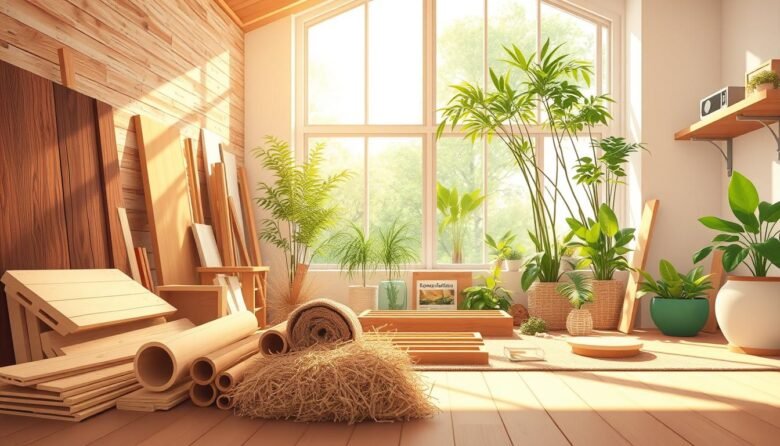Your home maintenance choices can make a real difference for our planet. Simple household projects using common items help reduce waste and protect natural resources.
These approaches lower your environmental impact while saving money. They also improve indoor air quality and reduce energy consumption.
Small changes add up to significant results over time. This guide shows practical ways to maintain your home responsibly.
We’ll explore simple principles, easy projects, and smart material choices. You’ll discover how everyday items can transform your living space.
Key Takeaways
- Home maintenance choices directly affect environmental impact
- Common household items can serve multiple purposes
- Small changes collectively reduce waste and energy use
- Responsible practices improve indoor air quality
- Smart material selection supports sustainability goals
- Simple fixes can lower your carbon footprint effectively
- Conscious maintenance saves money while helping the planet
Introduction to Sustainable Home Maintenance
Thoughtful upkeep decisions transform how your household interacts with natural systems. This approach prioritizes environmental responsibility through conscious repair and maintenance practices.
Sustainable home care extends item lifespan significantly. This reduces waste by minimizing disposal in landfills and decreasing manufacturing demands.
Energy efficiency plays a crucial role in responsible upkeep. Choosing low-consumption methods and tools lowers overall energy use during maintenance activities.
Water conservation represents another vital component. Mindful repair choices and routine checks prevent resource waste through leaks and inefficiencies.
Long-term benefits include reduced environmental impact and lower carbon footprint. These practices also contribute to healthier living spaces with improved air quality.
Every maintenance decision supports broader sustainability goals. Small changes collectively create meaningful positive change for our planet’s future.
The Core Principles of Eco-Friendly Restoration
Effective restoration begins with fundamental guidelines that guide material selection. These concepts help achieve lasting results while minimizing ecological effects.
Thoughtful approaches consider both immediate needs and long-term consequences. They balance functionality with environmental responsibility.
Sustainability in Materials and Methods
Choosing the right components matters for successful projects. Recycled and reclaimed options often provide excellent performance.
Non-toxic products protect both your household and the wider environment. They minimize harmful emissions during application and throughout their lifespan.
Advanced tools like moisture meters and thermal imaging cameras improve precision. These technologies help identify issues accurately, reducing unnecessary work.
Proper tool use prevents wasted effort and material consumption. It ensures repairs address actual problems rather than symptoms.
Conservation of Natural Resources
Water and energy preservation remains crucial in responsible restoration. Mindful practices significantly lower consumption during projects.
Renewable sources like solar power offer clean alternatives for tool operation. They reduce dependence on traditional electricity generation.
Efficient methods complete tasks using minimal resources. This approach respects planetary limits while achieving quality results.
Enhancing Indoor Environmental Quality
Non-toxic materials contribute to healthier living spaces. They release fewer volatile compounds into your home’s atmosphere.
Improved air quality benefits everyone in the household. Proper ventilation during projects further reduces potential contaminants.
Healthier interiors support overall well-being and comfort. They create spaces where families thrive without exposure concerns.
Biodiversity protection extends beyond indoor considerations. Native plants around your property support local ecosystems.
Minimal disruption approaches preserve existing habitats during exterior work. They maintain natural balances while addressing necessary repairs.
Repair vs. Replace: Making the Sustainable Choice
Every household faces decisions about maintaining or upgrading items. Choosing between restoration and replacement requires careful consideration of multiple factors.
This balance affects your household’s resource use and environmental consequences. Smart choices create positive change while supporting your lifestyle needs.
Assessing the Energy Impact of Appliances
Older appliances often consume more power than modern versions. Refrigerators over ten years old typically use significantly more electricity.
New energy-efficient models can cut consumption by forty percent or more. This reduction lowers your carbon footprint substantially over time.
Calculate potential savings before making final decisions. Compare repair costs against long-term energy savings from upgrades.
When Repairing is the Most Sustainable Path
Items with minimal energy use benefit most from restoration. Furniture, decor, and mechanical tools often work well with careful maintenance.
These solutions prevent additional waste from entering landfills. They also reduce manufacturing demands for new products.
Simple fixes extend item lifespan without significant resource investment. This approach supports circular economy principles effectively.
When Upgrading is the Responsible Option
Energy-intensive appliances sometimes warrant replacement rather than repair. New models offer advanced efficiency that older units cannot match.
Major kitchen and laundry appliances often show dramatic improvements. Their reduced energy consumption justifies the initial investment.
Consider total lifecycle impact when evaluating options. Sometimes innovation provides better long-term environmental benefits.
Balance immediate waste reduction against future energy savings. This perspective helps make truly sustainable choices for your home.
Essential DIY Eco Friendly Fixes for Every Home
Simple household improvements can transform your living space while protecting our planet. These hands-on projects use common items to address everyday issues.
You can tackle various areas with basic tools and minimal experience. These approaches save money while reducing your household’s ecological effect.
Plumbing Repairs: Faucets, Showerheads, and Leaking Pipes
Dripping faucets waste significant amounts of water over time. A simple washer replacement often solves this common problem.
Low-flow showerheads conserve water without sacrificing pressure. Installation requires only basic wrench skills and takes minutes.
Pipe leaks demand immediate attention to prevent structural issues. Epoxy putty creates temporary seals until professional help arrives.
Regular maintenance prevents major problems down the line. These small actions protect our precious water supplies effectively.
Kitchen Upkeep: Cabinets, Knobs, and Appliances
Cabinet hinges and handles often loosen with daily use. Tightening screws restores functionality without replacement.
Appliance maintenance extends their operational lifespan significantly. Cleaning refrigerator coils improves efficiency by thirty percent.
Simple adjustments keep everything working smoothly. These practices reduce manufacturing demands and landfill contributions.
Furniture Restoration and Creative Upcycling
Old furniture gains new life through thoughtful refurbishment. Sanding and staining techniques revive worn surfaces beautifully.
Reupholstering chairs and sofas transforms their appearance completely. This approach preserves quality frames while updating styles.
Creative repurposing gives items entirely new functions. An old ladder becomes unique shelving with minimal modification.
These projects minimize waste while expressing personal creativity. They keep useful items circulating within our households longer.
Improving Home Efficiency: Weatherstripping and Lighting
Drafty doors and windows increase heating and cooling costs. Self-adhesive weather stripping creates tight seals that block air leaks.
LED bulbs use seventy-five percent less electricity than incandescent options. They also last twenty-five times longer on average.
These upgrades lower energy bills while reducing power plant demands. Small changes make substantial differences in overall consumption.
Every improvement contributes to a more efficient household. They collectively decrease your carbon output meaningfully.
Selecting the Right Green Materials for Your Projects
Smart material selection transforms ordinary projects into planet-positive actions. Your choices directly influence resource consumption and waste generation.
Thoughtful picks create healthier living spaces while conserving precious resources. They represent conscious decisions that benefit both your household and our world.
Identifying Recycled and Reclaimed Materials
Recycled content gives new life to existing resources. Reclaimed wood and metal offer character while reducing manufacturing demands.
These options prevent additional items from entering overcrowded landfills. They support circular economy principles through intelligent reuse.
Look for materials with documented recycled content percentages. Many suppliers provide certification for verified reclaimed products.
Local salvage yards often contain hidden treasures for creative projects. Architectural salvage provides unique pieces with historical significance.
Choosing Non-Toxic and Biodegradable Products
Low-VOC paints and finishes significantly improve indoor air quality. They release fewer harmful compounds during application and drying.
Natural cleaning solutions break down safely without harming water systems. Plant-based formulas work effectively while being gentle on surfaces.
Biodegradable options minimize long-term environmental impact. They return to nature without leaving persistent residues.
Always check product labels for ingredient transparency and certifications. Reputable brands clearly list components and their sources.
Proper material selection supports broader conservation goals. It reduces extraction pressures on finite natural resources.
These choices also lower energy consumption throughout product lifecycles. They contribute meaningfully to carbon reduction efforts.
Durable selections withstand wear while maintaining performance standards. Quality components often outlast conventional alternatives.
Local suppliers reduce transportation emissions associated with material delivery. They also support regional economies and community businesses.
Every conscious choice creates positive change for our planet’s future. Your projects become part of larger environmental solutions.
Water Conservation Techniques and Repairs
Water management represents a critical component of household environmental responsibility. Thoughtful approaches to water use significantly affect your home’s resource consumption.
Quick leak repairs prevent substantial water loss over time. A single dripping faucet can waste hundreds of gallons monthly.
Low-flow fixtures reduce water use without compromising performance. These installations cut consumption while maintaining pressure.
Rain gardens manage stormwater naturally through strategic landscaping. They filter runoff while replenishing groundwater supplies.
Proper irrigation maintenance prevents overspray and evaporation loss. Adjust sprinkler heads seasonally for optimal coverage.
These approaches help reduce strain on municipal water systems. They also lower utility bills through decreased consumption.
DIY pipe sealing stops leaks with epoxy compounds or compression fittings. Most minor repairs require basic tools and minimal time investment.
Landscaping with native plants minimizes watering needs significantly. Regional species thrive with natural rainfall patterns.
Regular inspection identifies potential issues before major damage occurs. Monthly checks of fixtures and pipes prevent costly emergencies.
Water conservation supports broader sustainability goals effectively. Reduced consumption decreases energy needs for water treatment and distribution.
These practices collectively lower your household’s environmental impact. They preserve natural resources for future generations while saving money today.
Reducing Energy Consumption Through Smart Repairs
Strategic home improvements can dramatically lower your power usage. Simple adjustments to existing systems prevent energy loss and reduce utility costs.
Weatherstripping around doors and windows stops heated or cooled air from escaping. This simple fix maintains comfortable temperatures with less energy.
Upgraded insulation in attics and walls provides better thermal protection. These improvements work year-round to cut heating and cooling needs.
Energy-efficient appliances use significantly less electricity than older models. Modern refrigerators and washing machines perform better while consuming less power.
HVAC system maintenance ensures optimal performance with minimal energy. Clean filters and sealed ducts improve airflow and efficiency.
Fixing faulty wiring prevents energy waste through resistance and heat loss. Proper electrical connections ensure all systems operate at peak efficiency.
Solar-powered tools offer clean alternatives for outdoor projects. They eliminate emissions from small gasoline engines during yard work.
Programmable thermostats adjust temperatures automatically based on your schedule. This prevents unnecessary heating or cooling when nobody is home.
Proactive maintenance identifies issues before they cause energy waste. Regular checks catch problems early, preventing bigger repairs later.
These approaches lower your household’s carbon output meaningfully. They also reduce strain on power grids during peak demand periods.
Every improvement contributes to a more efficient home environment. Smart choices today create lasting benefits for both your budget and our planet.
Reducing Waste by Repairing Instead of Discarding
Conscious decisions about item longevity significantly influence our collective environmental footprint. Choosing restoration over replacement keeps functional goods circulating within our economy.
This approach prevents countless items from entering overcrowded disposal sites. It also reduces manufacturing demands for new replacements.
Every preserved item represents conserved energy and raw materials. Manufacturing new products requires substantial resource extraction and processing.
Thoughtful maintenance lowers greenhouse gas emissions from production facilities. It minimizes transportation needs associated with new goods distribution.
Identifying repairable items requires careful assessment of their condition and value. Simple mechanical items often respond well to basic restoration techniques.
Energy-intensive appliances need different evaluation criteria. Sometimes newer models offer efficiency gains that justify replacement.
DIY capabilities empower households to extend product lifespans effectively. Basic tools and online tutorials make many repairs accessible.
Community workshops provide shared tools and expert guidance. These spaces foster skill development and collective problem-solving.
Valuing restoration cultivates appreciation for quality craftsmanship and durability. This mindset shift supports circular economic principles.
Every repaired item represents reduced consumption and waste generation. These choices collectively decrease our environmental impact over time.
Simple maintenance practices create lasting positive change. They transform how we interact with possessions and resources.
Eco-Friendly Renovations and Larger Upgrade Options
Major home improvements offer significant opportunities to reduce your household’s environmental impact. These projects transform how your property interacts with natural systems while enhancing comfort.
Thoughtful renovation choices conserve precious resources and lower energy demands. They create healthier living spaces that benefit both your family and our planet.
Incorporating Reclaimed and Vintage Pieces
Reclaimed wood and vintage furniture bring character while reducing waste. These items prevent additional manufacturing demands and landfill contributions.
Architectural salvage provides unique solutions with historical significance. Local suppliers often offer quality pieces with documented origins.
These choices support circular economy principles through intelligent reuse. They extend product lifecycles while adding distinctive style to your spaces.
Non-toxic finishes preserve indoor air quality during refurbishment. Natural stains and low-VOC paints protect your household’s health.
Installing Solar Panels and Energy-Efficient Windows
Solar panel systems generate clean electricity from renewable sources. They significantly lower grid dependence while reducing carbon output.
Modern energy-efficient windows provide superior insulation year-round. Their advanced glazing technology maintains comfortable temperatures with less energy.
These upgrades offer long-term financial savings through reduced utility costs. They also increase property value while supporting broader conservation goals.
Professional installation ensures optimal performance and system longevity. Certified contractors understand local regulations and incentive programs.
Strategic planning maximizes both environmental benefits and return on investment. Consider orientation, shading, and energy needs when designing systems.
Every major improvement contributes to a more responsible household. These changes create lasting positive impact for our collective future.
Tackling Common Household Damage the Sustainable Way
Household issues require immediate attention to prevent larger problems. Quick action stops minor damage from becoming major headaches.
Water leaks demand prompt response to conserve resources. A small drip can waste gallons over weeks.
Mold growth needs careful handling to protect indoor air quality. Proper moisture control prevents its return.
Non-toxic cleaning agents safely remove stains and buildup. They protect your family’s health during cleanup.
Advanced tools like thermal imaging cameras pinpoint hidden moisture. This technology finds problems without destructive probing.
Accurate diagnosis prevents unnecessary material use and waste. It targets repairs exactly where needed.
Natural cleaners work effectively on various surfaces. Vinegar and baking soda handle many cleaning tasks.
Recycled materials make excellent patches for small repairs. Old fabric scraps can mend furniture tears beautifully.
Quick fixes preserve items that might otherwise get discarded. This approach reduces landfill contributions significantly.
Conscious maintenance supports broader conservation efforts. Every saved item means less manufacturing demand.
These methods contribute to healthier living environments. They minimize chemical exposure while solving practical issues.
Your actions create positive change for our planet’s future. Small steps collectively make substantial difference.
Embracing a Sustainable Mindset for Your Home’s Future
Every repair decision you make contributes to a larger pattern of resource conservation and waste reduction. Your conscious choices create meaningful change for our environment.
Thoughtful maintenance lowers energy consumption and preserves natural resources. It reduces landfill contributions and manufacturing demands. These practices benefit both your household and our planet.
Start with simple projects that improve air quality and reduce your carbon footprint. Gradually incorporate more advanced solutions as your skills develop.
Continuous learning empowers you to make increasingly responsible choices. Your commitment creates healthier living spaces while protecting our shared future.



